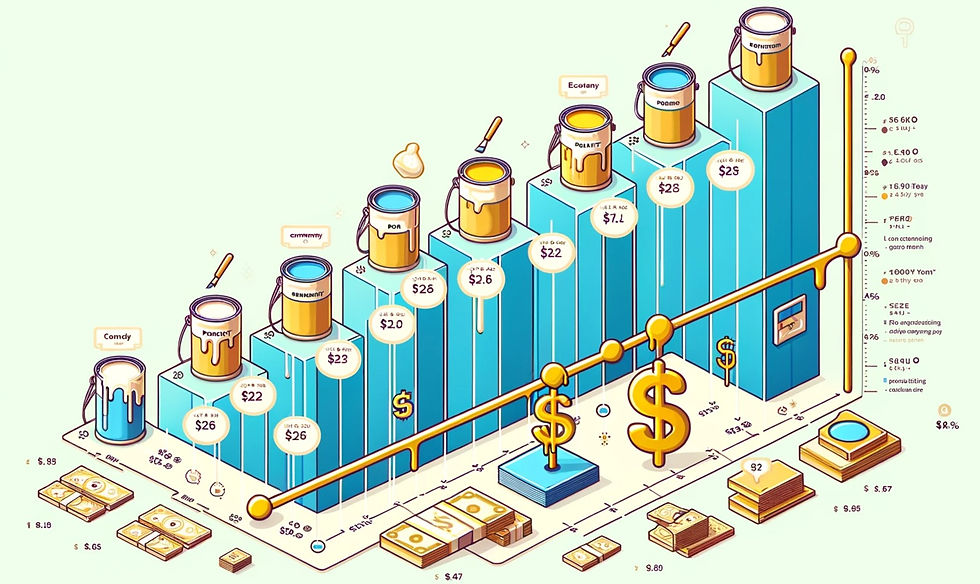Ultimate Guide to Saving on House Painting Costs in 2024
- Trevor Ross
- Mar 5, 2024
- 4 min read
Updated: Mar 11, 2024
By: Trevor Ross

Whether you're aiming to revamp your home's appearance or prepare it for sale, a fresh coat of paint can significantly boost its appeal. Painting is a project many homeowners consider doing themselves, but for those who prefer professional help, understanding the costs involved is crucial. Here's your comprehensive guide to budgeting for your home painting project in 2024.
Professional vs. DIY Painting: What to Expect
Hiring a Professional Painter
When opting for professional painting services, the cost can vary widely depending on several factors, including the size of your home, the type of paint used, and the complexity of the job. According to Angi, the price range for interior painting services in 2024 is estimated between $967 and $3,041, with the average cost around $1,985. This equates to an average of $2.75 to $4.70 per square foot, taking into account whether walls, trim, and ceilings are part of the project.
Tackling the Project Yourself
If you decide to paint your home's interior on your own, your primary expenses will involve primer, paint, and painting supplies. Primer prices typically range from $20 to $75 per gallon, while high-quality paint can cost between $15 and $60 per gallon. Lowe’s estimates that a gallon of paint covers 350 to 400 square feet, and a gallon of primer covers 200 to 300 square feet. The cost of additional supplies, such as brushes, rollers, and ladders, can vary based on your specific needs.

Breaking Down the Costs
Labor Costs
Labor is the most significant expense in a painting project, encompassing surface preparation and the painting process itself. Reducing the time required for these tasks can lead to substantial savings.
Paint and Materials
The cost of paint is the next major expense, with prices ranging from $15 to $60 per gallon or more, based on quality and features. High-quality paints may offer better coverage and durability, potentially reducing the overall amount of paint needed.

How to Save on Painting Costs
1. DIY Where Possible
Handling some or all of the painting work yourself can lead to significant savings. The main expense will be the paint, with additional costs for supplies and equipment.
2. Opt for High-Quality Paints
Investing in premium paints can be more cost-effective in the long run, offering better coverage and durability, which can reduce the total amount of paint needed for the project.
3. Prepare the Space Yourself
If you hire a professional, you can cut costs by doing prep work, such as moving furniture, removing outlet covers, and performing initial cleaning and sanding.
4. Get Multiple Bids
Comparing estimates from different painters can help you find the best price. Ensure the bids include detailed information about the scope of work, materials to be used, and the number of coats.
5. Trim the Scope
Review your contract for opportunities to reduce the project's scope, such as skipping non-essential areas, to save on paint and labor costs.
6. Time Your Project Right
Scheduling your painting project during off-peak seasons can result in better deals, though it's essential to consider the potential impact of weather conditions on the project's timeline and quality.
Prolonging the Paint's Life

Maintenance Tips to Extend Paint Lifespan
Painting your home is a significant investment in time, effort, and resources. Beyond the initial paint job, ensuring the longevity of your paint can save you from frequent repaints, thus conserving money in the long run. Here are some essential maintenance tips to extend the lifespan of your paint and keep your home looking vibrant and fresh.
1. Regular Cleaning
Interior: Dust and wash your walls periodically. Use a soft cloth or sponge and a mild detergent to gently clean the surfaces. This prevents the buildup of dust, grime, and oils that can degrade paint over time.
Exterior: Hose down your home's exterior at least once a year. For more stubborn dirt, use a soft-bristled brush and a mild soap solution to avoid damaging the paint.
2. Immediate Stain Removal
Tackle stains or marks immediately, especially on interior walls. The longer a stain sits, the harder it becomes to remove without harming the paint. Use a damp cloth and mild cleaning solutions for spot cleaning.
3. Monitor Moisture Levels
Excess moisture is a major enemy of paint, leading to peeling, bubbling, and mold growth. Ensure good ventilation in high-moisture areas like bathrooms and kitchens. For exteriors, keep gutters clean and landscaping trimmed to prevent water accumulation against the house.
4. Touch-Up as Needed
Keep some leftover paint for touch-ups. Small chips and scratches are normal with wear and tear but addressing them promptly can prevent larger areas of damage. Ensure the area is clean and dry before applying any touch-up paint.
5. Protect from Direct Sunlight
UV rays can fade and deteriorate paint over time. Use curtains, blinds, or window films to protect interior paint from direct sunlight. For exteriors, consider using paint formulated to resist UV damage in areas that get a lot of sun.
6. Regular Inspections
Conduct annual inspections of both the interior and exterior of your home. Look for signs of wear, such as cracking, peeling, or fading. Early detection allows you to address problems before they require a full repaint.
7. Use Quality Paints
Invest in high-quality paint with additives that resist mold, mildew, and fading. These paints may cost more upfront but will save you money by reducing the frequency of repaints.
8. Professional Advice
Consult with a professional painter or a home improvement expert if you're unsure about the best way to maintain your home's paint. They can offer specific advice tailored to your home's materials and climate.
Conclusion
Painting your home in 2024 requires careful planning and budgeting, whether you choose to hire professionals or take on the project yourself. By understanding the factors that influence costs and exploring ways to reduce expenses, you can achieve a stunning result without breaking the bank.







Comments